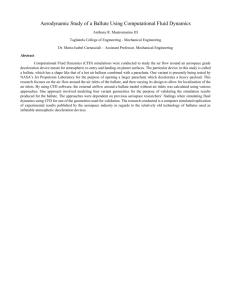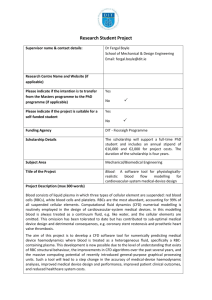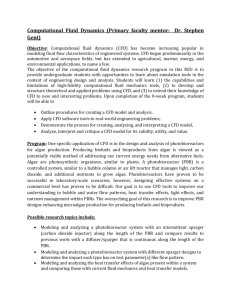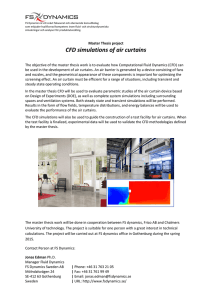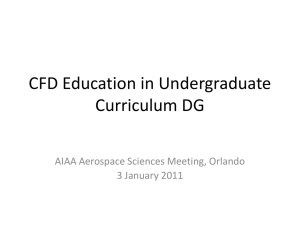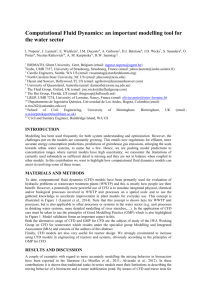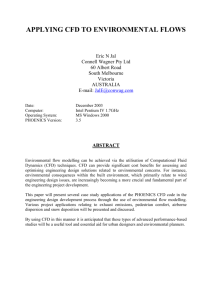Executive Summary
advertisement
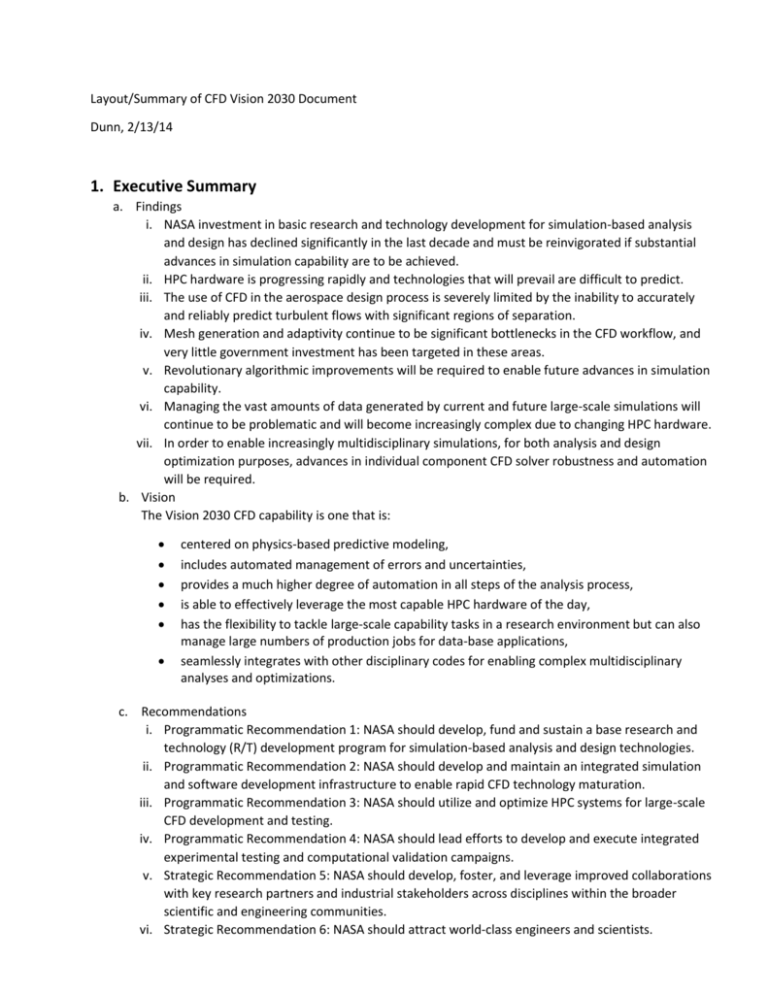
Layout/Summary of CFD Vision 2030 Document Dunn, 2/13/14 1. Executive Summary a. Findings i. NASA investment in basic research and technology development for simulation-based analysis and design has declined significantly in the last decade and must be reinvigorated if substantial advances in simulation capability are to be achieved. ii. HPC hardware is progressing rapidly and technologies that will prevail are difficult to predict. iii. The use of CFD in the aerospace design process is severely limited by the inability to accurately and reliably predict turbulent flows with significant regions of separation. iv. Mesh generation and adaptivity continue to be significant bottlenecks in the CFD workflow, and very little government investment has been targeted in these areas. v. Revolutionary algorithmic improvements will be required to enable future advances in simulation capability. vi. Managing the vast amounts of data generated by current and future large-scale simulations will continue to be problematic and will become increasingly complex due to changing HPC hardware. vii. In order to enable increasingly multidisciplinary simulations, for both analysis and design optimization purposes, advances in individual component CFD solver robustness and automation will be required. b. Vision The Vision 2030 CFD capability is one that is: centered on physics-based predictive modeling, includes automated management of errors and uncertainties, provides a much higher degree of automation in all steps of the analysis process, is able to effectively leverage the most capable HPC hardware of the day, has the flexibility to tackle large-scale capability tasks in a research environment but can also manage large numbers of production jobs for data-base applications, seamlessly integrates with other disciplinary codes for enabling complex multidisciplinary analyses and optimizations. c. Recommendations i. Programmatic Recommendation 1: NASA should develop, fund and sustain a base research and technology (R/T) development program for simulation-based analysis and design technologies. ii. Programmatic Recommendation 2: NASA should develop and maintain an integrated simulation and software development infrastructure to enable rapid CFD technology maturation. iii. Programmatic Recommendation 3: NASA should utilize and optimize HPC systems for large-scale CFD development and testing. iv. Programmatic Recommendation 4: NASA should lead efforts to develop and execute integrated experimental testing and computational validation campaigns. v. Strategic Recommendation 5: NASA should develop, foster, and leverage improved collaborations with key research partners and industrial stakeholders across disciplines within the broader scientific and engineering communities. vi. Strategic Recommendation 6: NASA should attract world-class engineers and scientists. 2. Introduction a. 3. Vision for CFD a. Capabilities i. Emphasis on physics-based, predictive modeling. In particular, transition, turbulence, separation, chemically-reacting flows, radiation, heat transfer, and constitutive models must reflect the underlying physics more closely than ever done before. ii. Management of errors and uncertainties resulting from all possible sources: (a) physical modeling errors and uncertainties addressed in item #1, (b) numerical errors arising from mesh and discretization inadequacies, and (c) aleatory uncertainties derived from natural variability as well as epistemic uncertainties due to lack of knowledge in the parameters of a particular fluid flow problem. iii. A much higher degree of automation in all steps of the analysis process is needed including geometry creation, mesh generation and adaptation, the creation of large databases of simulation results, the extraction and understanding of the vast amounts of information generated, and the ability to computationally steer the process. iv. Ability to effectively utilize massively parallel, heterogeneous, and fault-tolerant HPC architectures v. Flexibility to tackle capability- and capacity-computing tasks in both industrial and research environments vi. Seamless integration with multi-disciplinary analyses that will be the norm in 2030 b. Grand Challenge Problems i. LES of a powered aircraft configuration across the full flight envelope ii. Off-design turbofan engine transient simulation iii. MDAO of a highly-flexible advanced aircraft configuration iv. Probabilistic analysis of a powered space access configuration 4. Current State a. Design Phases i. Conceptual Design. CFD is often used in the early, conceptual design of products where it has been both previously calibrated for similar applications using data-morphing techniques, as well for brand new configurations where little or no engineering data is available to guide design decisions. Simplified models are typically used during the conceptual optimization phase, to allow reasonably accurate trades to be made between drag, fuel consumption, weight, payload/range, thrust, or other performance measures. ii. Preliminary/Detailed Design. Once a product development program is launched, CFD is a necessary, and uniformly present, tool in the detailed configuration design process. For example, CFD is indispensable in the design of cruise wings in the presence of nacelles for commercial airplanes, and for inlet and nozzle designs; wind tunnels are used to confirm the final designs1, 4. In both military and commercial aircraft design processes, CFD is the primary source of data for aircraft load distributions and ground effect estimations10. Similarly, gas turbine engine manufacturers rely on CFD to predict component design performance, having reduced the number of single-component rigs substantially as CFD capability has become more mature5,6. Increasingly, multi-component and multi-physics simulations are performed during the design cycle, but the often long clock times associated with these processes restricts their widespread adoption. For space exploration, CFD is often used to gain important insight into flow physics (e.g., multiple plume interactions) used to properly locate external components on the surface of launch vehicles or spacecraft9, 27, 29. CFD is also increasingly providing substantial portions of the aero and propulsion performance database7, 9, 30. In many cases, wind tunnel data is being used only to anchor the CFD data at a few test points to provide confidence in the CFD database. Also, CFD is the primary source of data for the hypersonic flight regime where ground testing is limited or does not exist. iii. Product Validation and Certification. As the product development process moves into the validation phase and certification testing, CFD is often used to confirm performance test results, assess the redesign of components that show potential for improved performance, and to answer any other questions that arise during product testing. Typically, product configurations evolve over the testing period based on a combination of measured results and engineering judgment bolstered by the best simulation capability available. In general, CFD modeling capability grows to capture the required scope and physics to answer the questions raised during testing. It is the expense of responding to often unplanned technical surprises – which results in more time on the test stand or in flight test, or changes in hardware – that drives conservatism into aerospace designs, and is a significant motivation for improving the accuracy and speed of CFD. If CFD is sufficiently accurate and fast, engineers can move away from their traditional design space with greater confidence and less potential risk during testing b. Current state of CFD in several key technical areas: i. High Performance Computing (HPC). The effectiveness and impact of CFD on the design and analysis of aerospace products and systems is in large part driven by the power and availability of modern HPC systems. Over the last decades, CFD codes have been formulated using messagepassing (e.g., MPI) and thread (e.g., OpenMP) software models for expressing parallelism to run as efficiently as possible on current-generation systems. However, with the emergence of truly hierarchical memory architectures having numerous graphical processing units (GPUs) and coprocessors, new CFD algorithms may need to be developed to realize the potential performance offered by such systems. ii. Turbulence Modeling. Current practices for CFD-based workflows utilize steady Reynolds-average Navier-Stokes (RANS) with 1- or 2-equation turbulence models46-48, although hybrid unsteady RANS/LES methods are increasingly common for certain classes of simulations in which swirling and intentionally separated flows are dominant, such as combustors. Techniques to combine near-wall RANS regions and outer flowfield Large-eddy simulation (LES) regions in these hybrid methods are immature. Many CFD design processes include an estimation of boundary layer transition, using a range of models, from purely empirical to coupled partial-differential equation (PDE) solutions of stability equations49, 50. However, no generalized transition prediction capability is in widespread use. Steady-state CFD accounts for a vast majority of simulations; unsteady flow predictions are inherently more expensive and not yet uniformly routine in the design process, with some exceptions51. iii. Process Automation. Current CFD workflows are often paced by the geometry pre-processing and grid generation phases, which are significant bottlenecks. In some cases, where the design effort involves components of similar configurations, specialized, automated processes are built that considerably reduce set-up time, execution of the CFD solver, and post-processing of results. iv. Solution Uncertainty and Robustness. In practice, CFD workflows contain considerable uncertainty that is often not quantified. Numerical uncertainties in the results come from many sources, including approximations to geometry, grid resolution, problem set-up including flow modeling and boundary conditions, and residual convergence. Although NASA and professional organizations such as ASME and AIAA have created standards for the verification and validation of CFD and heat transfer analyses52-54, such techniques are not widely used in the aerospace industry. With a few notable exceptions, CFD is carried out on fixed grids that are generated using the best available practices to capture expected flow features, such as attached boundary layers55. Such approaches cannot reliably provide adequate resolution for flow features whose locations are not known a priori, such as shocks, shear layers and wakes. Although grid refinement is often seen as a panacea to addressing grid resolution issues, it is seldom done in practice (with the exception of a few workshop test cases) because uniform refinement is impractical in three dimensions. Adaptive mesh refinement strategies offer the potential for superior accuracy at reduced cost, but have not seen widespread use due to robustness, error estimation, and software complexity issues. Achieving consistent and reliable flow solver or residual convergence remains problematic in many industrial cases. Although many CFD codes are able to demonstrate convergence for a few simple problems, for many flows involving difficult flow physics and/or complex geometries such as an aircraft in high-lift configuration, many of the current solver techniques employed are not strong enough to ensure robust convergence56. Engineering judgment is required to interpret results that are not well converged, which also introduces conservatism into decision making. Furthermore, the use of steady-state flow solvers itself is in question for many flows of engineering interest. v. Multi-Disciplinary Analysis and Optimization (MDAO). Although the basic concepts of MDAO are fairly well accepted in the community, the routine use of MDAO methods is not, by any means, pervasive. At moderate levels of fidelity (commensurate with analyses carried out during the conceptual design phase), it is common in industrial practice to perform coupled multidisciplinary analyses (MDAs) of the most tightly integrated disciplines in a design: aero-structural analyses, conjugate heat transfer calculations, and aero-acoustic simulations all tend to take place in aircraft, spacecraft, jet engine, and rotorcraft analysis and design processes. High-fidelity CFD is not routinely used in such MDAs, although recent years have witnessed a significant rise in the coupling of state-of-the-art CFD with additional disciplines. 5. CFD Technology Gaps and Impediments Given the current state of CFD technology, tools, and processes described above, necessary research and development to address gaps and overcome impediments in CFD technology are fundamental to attaining the vision for CFD in 2030 outlined earlier. Five key technical areas were identified during this Vision 2030 study and, in particular, rose to the highest level of importance as identified from a user survey and workshop of a large international community of CFD researchers and practitioners. a. Effective Utilization of High-Performance Computing (HPC). CFD in 2030 will be intimately related to the evolution of the computer platforms that will enable revolutionary advances in simulation capabilities. i. Hardware system power consumption. Current state-of-the-art computing systems consume too much power to be scaled up substantially, utilize too large structural components, and don’t provide the level of computational and communication speed necessary. ii. Higher levels of software extraction. The increased complexity of HPC exascale systems in 2030 will require higher levels of automation and the ability to hide this complexity from the subject matter experts. iii. Advanced programming environments. Another critical component in the development of the full future HPC ecosystem is the development of basic highly scalable and error resistant algorithms, decomposable software architectures, and programming environments that allow scientific subject matter experts to express algorithms at the appropriate level of abstraction. iv. Robust CFD code scalability. An HPC system in 2030 will require tremendous levels of parallelization. Unfortunately, robust CFD flow solver scalability even on current multi-core platforms is sorely lacking. v. Lack of scalable CFD pre- and post-processing methods. Despite the deficiencies in current CFD solver scalability, the situation for the surrounding infrastructure of pre and post-processing software is even worse. In order to streamline and accelerate the entire CFD workflow and design process, the development of basic scalable pre- and post-processing methods must be addressed. This includes geometry representation and mesh generation on the front end as well as visualization, data-base generation, and general knowledge extraction from large data-sets on the back end. vi. Lack of access to HPC resources for code development. Another key issue is the lack of access to large-scale HPC resources as an integral part of software development. Consistent and reliable access to leading-edge HPC hardware is critical for devising and testing new techniques that enable more advanced simulations, as well as for demonstrating the impact that CFD technology enhancements can have on aerospace product development programs. b. Unsteady Turbulent Flow Simulations Including Transition and Separation. Perhaps the single, most critical area in CFD simulation capability that will remain a pacing item by 2030 in the analysis and design of aerospace systems is the ability to adequately predict viscous turbulent flows with possible boundary layer transition and flow separation present23, 31, 63, 64. While steady, fully-turbulent attached flows can be predicted reasonably well with current RANS methods at all speed regimes23, 65, 66, all types of separated flows continue to be difficult to predict. In particular, smooth body separation remains very hard to simulate accurately and efficiently for high-speed (buffet-limited) stall, low-speed high-lift, inlets at crosswind conditions, engine simulations and compressor stall, flows at the edges of the design envelope, and for maneuvering flight with moving control surfaces. In general, there are two critical components of flow physics that need to be modeled accurately: the exact location of separation as controlled by boundary-layer physics, and the feedback from the separated region to the boundary layer. i. Lack of a theoretically-based, hybrid RANS-LES turbulence simulation capability. Ideally, unsteady flow simulations using advanced turbulence models (e.g., DES, full LES, etc.) should be used to resolve the key turbulent length scales that drive development and propagation of flow separation. . . . Unfortunately, hybrid methods are currently cost-prohibitive for routine use on realistic configurations at Reynolds numbers of interest in aerospace, at least in the thinner regions of the boundary layer such as near the wing attachment line. ii. Availability and convergence of complex turbulence models in practical codes. A recurring issue in using elaborate RANS models with second moment closures (e.g., Reynolds Stress Transport methods, etc.) for practical applications is both their availability in widely used flow solvers (e.g., FUN3D, Overflow, etc.) and their notoriously poor convergence characteristics for flow simulation involving complex geometries and/or complex flow physics. iii. Effects of grid resolution and solution scheme in assessing turbulence models. A key gap in the effectiveness of current and future turbulence models is the effect of grid resolution and solution scheme on both the accuracy and convergence properties of the models. iv. Insufficient use of foundational validation/calibration datasets to drive physics-based improvements to turbulence prediction. Key experimental datasets are critically important in the ongoing development and refinement of the full range of turbulence models from RANS to LES. v. Insufficient use of “real world” experiments to validate turbulence models. In addition to building-block experiments, more specific test data from complex, integrated flow fields using geometries that are more representative of complex aerospace systems is needed. vi. Robust transition prediction capability. Boundary layer transition is not well predicted (if at all) in CFD practice, impacting wind tunnel to flight scaling, laminar flow prediction and control, turbomachinery design, and hypersonic transition/heating analysis, among others. Transition modeling for lower Reynolds number applications is particularly lacking, with specific impact on high bypass ratio turbomachinery and for the lower Reynolds number vehicles being designed today. vii. Lack of explicit collaboration among turbulence researchers. In general there is a general lack of close coordination between turbulence modelers and researchers both in the aerospace field itself (scattered amongst academia, industry, and government), and between researchers in aerospace and related fields. c. Autonomous and Reliable CFD Simulation. Today, most standard CFD analysis processes for the simulation of geometrically complex configurations are onerous, both in terms of cycle time and process robustness. Mesh Generation and Adaptivity. Today, the generation of suitable meshes for CFD simulations about complex configurations constitutes a principal bottleneck in the simulation workflow process. Often the mesh generation phase constitutes the dominant cost in terms of human intervention . . . i. Inadequate linkage with CAD: Configuration geometry definitions required by mesh generation software are generally provided by computer-aided design (CAD) packages. However, there is currently no single standard for representing surface or solid geometries within CAD tools, complicating efforts to fully automate the link between mesh generation and geometry definition. Furthermore, many existing CAD geometry definitions are ill-suited for CFD analyses, either due to insufficient accuracy (non water-tight geometries often adequate for manufacturing purposes), or due to excessive detail not essential for the CFD analysis. P ii. Poor mesh generation performance and robustness: Significant human intervention is often required in the mesh generation process due to lack of robustness. iii. Limited use of adaptive meshing techniques: While the benefits of adaptive mesh refinement (AMR) methods have been known for several decades, the incorporation of fully automated adaptive meshing into production level CFD codes remains scarce51, 83. Our vision of fully automated and invisible meshing technology relies implicitly on the use of adaptive meshing. Error Control and Uncertainty Quantification. Errors in current CFD simulations are not well understood or well quantified, including errors due to spatial and temporal discretization, incomplete convergence, and the physical models and parameters they embody. The lack of error quantification raises the risk that engineering decisions are based on inaccurate and/or uncertain results. i. Limited use of existing error estimation and control methods: Significant progress has been made in the estimation and control of discretization errors, in particular in terms of output-based techniques90-93. However, while these techniques have been demonstrated by multiple groups for steady two-dimensional RANS94 and three-dimensional inviscid flows83, the applications to threedimensional RANS and unsteady flows have been limited in particular for complex geometries. ii. Inadequacy of current error estimation techniques: While discretization error estimation techniques for outputs have improved over the past ten years, these techniques do have fundamental limitations which could impact their application to increasingly complex problems.) iii. Limited use of uncertainty quantification: The consideration of uncertainty due to parametric variability as well as modeling error raises significant challenges. Variability and uncertainty of inputs (boundary and initial conditions, parameters, etc) to fluid dynamic problems are largely unquantified. Even if estimates are available and/or assumed, the propagation of these uncertainties poses a significant challenge due to the inherent cost, the lack of automation and robustness of the solution process, and the poor utilization of high performance computing. Even more challenging is the quantification of modeling error. d. Knowledge Extraction and Visualization. An integral part of effectively using the advanced CFD technology envisioned in 2030 is the way in which the very large amount of CFD-generated data can be harvested and utilized to improve the overall aerodynamic design and analysis process, including insight into pertinent flow physics, use with aerodynamic or multi-disciplinary optimization, and generation of effective databases for a myriad of purposes, including control law development, loads assessment, flight/performance simulation, etc. i. Effective use of a single, high-fidelity CFD simulation. As high-performance computing (HPC) systems become faster and more efficient, a single unsteady CFD simulation using more complicated physical models (e.g., combustion) to solve for the flow about a complete aerospace system (e.g., airplane with full engine simulation, space vehicle launch sequence, aircraft in maneuvering flight, etc.) using a much higher number of grid points (~10-100 billion) will become commonplace in the 2030 timeframe. ii. Real-time processing and display of many high-fidelity CFD simulations. By the year 2030, HPC capabilities will allow for the rapid and systematic generation of thousands of CFD simulations for flow physics exploration, trend analysis, experimental test design, design space exploration, etc. The main goal, therefore, is to collect, synthesize, and interrogate this large array of computational data to make engineering decisions in real time. iii. Merging of high-fidelity CFD simulations with other aerodynamic data. With wind tunnel and flight testing still expected to play a key role in the aerospace system design process, methods to merge and assimilate CFD and multidisciplinary simulation data with other multi-fidelity experimental/computational data sources to create an integrated database, including some measure of confidence level and/or uncertainty of all (or individual) portions of the database, are required. e. Multi-Disciplinary/Multi-Physics Simulations and Frameworks. We also assume that CFD capabilities in 2030 will play a significant role in routine, multi-disciplinary analysis (MDA) and optimization (MDAO) that will be typical of engineering and scientific practice. In fact, in 2030 many of the aerospace engineering problems of interest will be of a multi-disciplinary nature and CFD will have to interface seamlessly with other high-fidelity analyses including acoustics, structures, heat transfer, reacting flow, radiation, dynamics & control, and even ablation and catalytic reactions in thermal protection systems.. The vision for 2030 MDA/O involves the seamless setup and routine execution of both multi-disciplinary analyses and optimizations with: Rapid turnaround (hours for MDA and less than a day for MDO), User-specified accuracy of coupled simulations, Robustness of the solution methodology, Ability to provide sensitivity and uncertainty information, and Effective leveraging of future HPC resources. i. Robustness and automation of CFD analyses in multi-disciplinary environments. In order to ensure that 2030 CFD can be an integral part of routine multi-disciplinary, multi-physics simulations, the manpower cost required to setup and execute such calculations must be drastically reduced. ii. The science of multi-disciplinary coupling at high fidelity. Exchanges of information between Vision 2030 CFD and other disciplinary solvers with which CFD will need to interact will require assurances of both accuracy and stability. iii. Availability of sensitivity information and propagation of uncertainties. Vision 2030 CFD is expected to interact with other solvers (for different disciplines) in multi-disciplinary analyses and optimizations. In 2030, the state of the art is presumed to include the quantification of uncertainties (UQ), at the system level, arising from uncertainties in each of the participating disciplines. iv. Standardization and coupling frameworks. Owing to the multitude of disciplinary solvers available for coupling with 2030 CFD, and the uncertainty regarding the actual code structure, HPC solver architecture, and internal solution representation, it is fundamental to ensure that multi-disciplinary simulation standards (such as the CGNS standard107 created for CFD) are created so that a variety of solvers can participate in multi-disciplinary analyses and optimizations. 6. Technology Development Plan To achieve our vision of CFD in 2030 and directly address the key CFD technology shortcomings and impediments that currently limit the expanded use of CFD methods within the aerospace analysis and design process, a comprehensive CFD development plan has been developed and is presented in this section. a. Grand Challenge Problems i. LES of a powered aircraft configuration across the full flight envelope ii. Off-design turbofan engine transient solution iii. MDAO of a highly-flexible advanced aircraft configuration iv. Probabilistic analysis of a powered space access configuration b. Technology Roadmap i. High Performance Computing (HPC) ii. Physical Modeling iii. Numerical Algorithms iv. Geometry and Grid Generation v. Knowledge Management vi. Multidisciplinary Design and Optimization 7. Recommendations a. Development of a Comprehensive Revolutionary Computational Aerosciences Program i. Recommendation 1: NASA should develop, fund and sustain a base research and technology (R/T) development program for simulation-based analysis and design technologies Physics-based simulation is a cross-cutting technology that impacts all of NASA aeronautics missions and vehicle classes, as evidenced by the common themes in the NAE Decadal survey report12. In addition, technologies developed within NASA’s Aeronautics Research Mission Directorate impact many other aspects of the missions of various other NASA directorates. Yet, until recently, there has been no systematic program for developing simulation technologies, and all advances in simulation and CFD methods have had to be justified by potential short term impacts on one of the existing programs, or have been done in response to critical simulation failures observed through the course of a program. This leads to the preference for small improvements to existing software, with the result that most current software is over twenty years old, and the initiation of any new software project cannot be supported. b. Programmatic Considerations i. Recommendation 2: NASA should develop and maintain an integrated simulation and software development infrastructure to enable rapid CFD technology maturation. To reach the goals of CFD in 2030, research and technology development must effectively utilize and leverage in-house simulation expertise and capabilities with focused attention to HPC infrastructure, software development practices, interfaces, and standards. Maintain a World-Class In-House Simulation Capability ii. Streamline and Improve Software Development Processes Emphasize CFD standards and interfaces Recommendation 3: NASA should make available and utilize HPC systems for large-scale CFD development and testing. Access to leading-edge HPC hardware is critical for devising and testing new techniques that enable more advanced simulations, for demonstrating the impact that CFD technology enhancement can have on aerospace product development programs, and for addressing the Grand Challenge problems defined previously. iii. Recommendation 4: NASA should lead efforts to develop and execute integrated experimental testing and computational validation campaigns. Over the past decade, workshops to assess CFD predictive capabilities have been effective in focusing attention in key areas important to the aerospace community such has drag prediction, high-lift prediction, and aeroelasticity, to name a few. In most cases, the workshops involve CFD simulation of challenging flow physics on realistic geometries. If available, experimental data is used to anchor the CFD predictions. However, with the exception of the Common Research Model (CRM) model development150 and transonic test campaign151, workshops typically rely on pre-existing experimental datasets that often have an incomplete set of test data available, quality control issues, or a combination of both. Moreover, in many cases, the geometry definition of the tested configuration must be refurbished for CFD grid generation purposes. To help achieve the vision of CFD in 2030, an integrated approach involving well-designed groundbased (and perhaps flight) experiments to provide high quality datasets directly coupled with CFD technology and application code verification and validation is required. c. Strategic Considerations i. Recommendation 5: NASA should develop, foster, and leverage improved collaborations with key research partners and industrial stakeholders across disciplines within the broader scientific and engineering communities. 1. Leverage other government agencies and stakeholders (US and foreign) outside of the aerospace field. Currently, NASA ARMD's interaction with other government entities is almost exclusively focused on agencies that have a major stake in the national aeronautics enterprise such as the Federal Aviation Administration (FAA), United Stated Air Force (USAF) and others. However, in the last decade, computational science has had important visibility at the national level, through various competitive thrusts, and has become an important focus for various agencies such as the DoE, NSF and the National Institute of Standards and Technology (NIST). Therefore, it is natural for NASA ARMD, which performs the bulk of the R/T in computational science for the agency, to seek out and establish meaningful collaborations with these traditionally non-aerospace focused agencies. However, such collaborations have been sorely lacking. 2. Improve collaboration with industry. NASA has been at the forefront of CFD technology for decades and has been responsible for introducing much of the CFD technology in use in industry today. At the same time, in collaboration with universities, industry has addressed additional CFD technology needs that are unique and essential to their business success. These include increased emphasis in the areas of physics-based modeling, rapid complex geometry and grid capabilities, managing the generation of CFD-based aerodynamic design matrices, improving accuracy and robustness, and integrating CFD databases with experimental data and other disciplines. The result has been a substantial reduction in physical testing but not uniformly across all products or flow regimes. Continued advances are required to address full flight envelope predictions and propulsion system operating conditions, reduce design cost and cycle time, reduce ground and flight testing, and enable product certification through analysis. 3. Emphasize basic funding in applied math and computer science. In order to advance the state-of-the-art of CFD, advances must also be sought in related disciplines such as applied mathematics and computer science. We have made various references to these throughout the report, invoking such areas as computational geometry for grid generation, applied mathematics for linear and non-linear solver development, and computer science issues related to HPC. The specific areas of CFD, as well as the broader area of MDAO are components of the general field of computational science, which lies at the intersection of applied math, computer science, and an application science area, in this case, aerodynamics, or more broadly aerospace engineering. 4. Develop and foster collaborations with other disciplines through the creation of research institutes. As mentioned above, investments in applied math and computer science will be critical for achieving specific advances in CFD. Likewise, advances in MDAO will require investments in key disciplines outside of traditional aerodynamics. . . . NASA should reexamine the role such institutes have played in the overall long term success of computational methods within the agency and develop a new initiative to create an institute devoted to the advancement of both CFD and MDAO for NASA aeronautics, science and space exploration mission directorate problems. The goal of the institute would be to broaden NASA interactions with the wider scientific community and to foster long term collaborations with experts in important complementary fields. ii. Recommendation 6: NASA should attract world-class engineers and scientists The ability to achieve the long-term goals for CFD in 2030 is greatly dependent on having a team of highly-educated and effective engineers and scientists devoted to the advancement of computational sciences. This is particularly critical within NASA given the demographics of the current workforce: opportunities to stabilize and expand CFD and simulation personnel in the future should be pursued to enable a renewed leadership role in CFD development including researchers and developers with diverse backgrounds (physical modeling, numerical algorithms, applied mathematics, computer science, software development and various aerospace engineering application domains). 8. Conclusions 9. Acknowledgements 10. References
